Types of toilets by technical characteristics and design
The presence of properly functioning plumbing is one of the main factors for comfortable living in a city apartment and a comfortable cottage.The correct choice of plumbing fixtures is the key to the ease of use of this modern equipment. Do you agree?
The article presented to your attention describes in detail all currently existing types of toilets. They differ in the location of the outlet pipe into the sewer and the installation method closely related to it. In order to make a purchase consciously and without mistakes, we have given the technical and design features of an important device in everyday life.
The content of the article:
Classification of modern toilets
It is difficult to imagine a modern bathroom without a toilet. This is an indispensable item in an apartment or indoor toilet. It is impractical to use a chamber pot today, unless it has lost its relevance for serving small children.
The plumbing fixture in question (toilet) must be present in the apartment and private house.
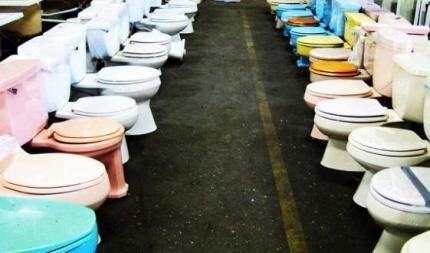
According to standards, the height of a regular toilet is 400–405 mm, and that of a child’s toilet is 335 mm. Most models are designed for a static load of 200 kg, but some manufacturers also produce products that can withstand up to 600 kg of weight. According to the norms, the drain tank will contain 6 or 4 liters of water. These are standard specifications for all toilet models.
Types #1: by material of manufacture
In the vast majority of cases, toilet bowls and water tanks are selected from the same material. The exception is separate models with installation. Their drain tank is placed in a niche in the wall and is often made of plastic or metal, and the bowl installed next to it is usually made of sanitary ware.
Different manufacturers use:
- Earthenware is the most popular and cheapest product, a classic in domestic apartments.
- Porcelain is an expensive, but durable and sophisticated option.
- Metal – mostly models for toilets in public buildings.
- Plastic is still exotic, made from fiberglass and acrylic.
- If you take stone, it will be from an artificial version, which is cheaper and stronger than natural one.
The seat (toilet) and lid are made mainly of plastic. But designer models can also be equipped with wooden counterparts coated with waterproof varnish. Other materials are not used here for reasons of hygiene and comfort.
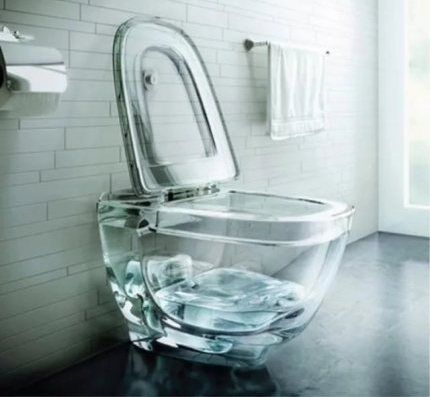
With the exception of metal products, all toilet options made from other materials do not withstand impact loads well. When a heavy object falls on them, they simply crack.
The most common types in everyday life are earthenware and porcelain plumbing fixtures. Earthenware is cheap, but it is porous and has a high water absorption rate of 10–12%. To avoid damage from moisture, I cover it with glaze.
Only it can provide protection to the base material of the bowl.If the decorative glazed layer is damaged, then the earthenware toilet needs to be replaced immediately. It can no longer be used.
Types #2: bowl-shaped
Manufacturers have no restrictions on the shape of the bowl. They are guided solely by design issues and customer preferences. However, there are some standard sizes that are common in layout and appearance.
There are three main types of toilet bowl shapes:
- Visors.
- Disc-shaped.
- Funnel-shaped.
Visor toilets are characterized by a drain shifted forward from the tank and a flat or slightly concave rear wall inside the bowl. Excrement slides down it into the water without creating splashes.
Such a bowl often leaves traces of feces and a corresponding smell. And even draining the water does not always allow you to completely get rid of such residues; you will have to use a brush often.
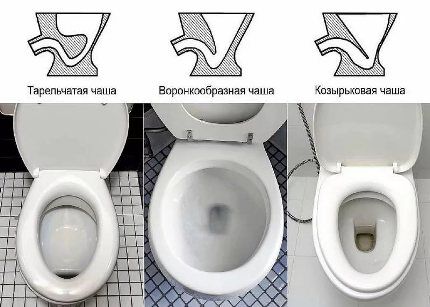
The drain of the dish-shaped variety is also shifted forward. However, the back wall of this type of toilet is made in the form of a horizontal shelf (plate, ledge). The waste products first fall on it, and then are only washed away when water is supplied to the drain and further into the sewer. The result is dirty stains and odors.
He will introduce you to the means and methods of combating sediment on the surface of the toilet bowl. next article, fully devoted to this important issue.
Another disadvantage of this design is the constant presence of small volumes of water on the shelf.And this inevitably leads to the accumulation of salt deposits on the ledge, which is always problematic to get rid of. If the water flowing from the pipes is dirty and hard in composition, then a yellowish pattern of salts will quickly appear on the walls of the toilet.
In the funnel-shaped version, the drain hole is located almost in the middle of the bowl. When using such a toilet, the least amount of odors and traces are generated; the waste immediately falls into the water in the funnel. But this plus is greatly offset by frequent splashes when visiting the toilet “in large quantities”.
Types #3: by cistern
According to the “tank+bowl” layout, a distinction is made between combined and separate (low and high) structures. The first type of toilets is made in the form of monoblocks and bolted elements. The tank in them is part of the structure, because cast together in a single body.
Separate options are toilets with a tank on the toilet shelf or a container on the wall. Water is drained into them through a hole adjacent to the tank and bowl or through a drain pipe made of metal or plastic.
Due to the high location of the tank, the drainage speed in such designs is higher, which ensures high-quality flushing of sewage. But they also make more noise when pressing the shutter lever than their combined counterparts.
The drain mechanism is activated after:
- tugging on a hanging rope or chain;
- pressing the handle;
- pressing the button.
The device for collecting/discharging water in the tank consists of a float valve (shut-off valve), a plastic float and a lever system. As the container fills, the float shut-off and drain valves rises, causing the water supply to shut off. After draining into the bowl, the tank is empty, and the process of filling it starts again.

The water supply system to the tank is:
- bottom;
- side.
In the first case, the supply pipe is connected to the toilet cistern from below, and in the second - from the right or left. With a bottom connection, the float is connected directly to the vertical rod in the valve, and with a side connection, through a horizontal lever with a valve on the side wall of the container.
In terms of volume, the toilet tank is designed for 4 or 6 liters of water. It can be of any shape and design. There are both standard rectangular and triangular models for installation in a corner.

There are many mechanisms for draining water into a bowl, but the simplest and most common option is a “pear” in the form of a small rubber plunger. Normally, the weight of the liquid in the tank presses it against the drain hole. But when you press the button, it rises and the water flows by gravity into the bowl. And as the container fills, the liquid again presses it to the bottom, blocking the outlet.
Types #4: by flush type
Toilets also differ in the type of drainage system inside the bowl.
There are three options for the movement of water in it:
- horizontal (cascade);
- circular twisted;
- circular straight line.
The horizontal flush creates a powerful flow in the most contaminated area of the toilet bowl. However, in general, water washes a little more than half the area of the walls, because of this it is often necessary to clean them with a brush.
This type of domestic toilet was mass-produced under the Soviet Union. Now manufacturers have switched to the second and third options, which are more suitable from a hygiene point of view, with water moving in a circle.
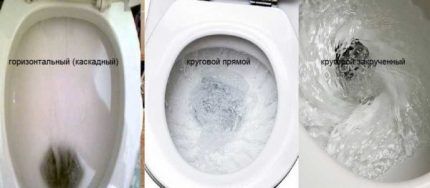
With a circular type of flush, a gutter with holes is made along the edge of the entire bowl. When discharged from the tank, water is distributed evenly over the entire surface. This type of toilet is characterized by greater efficiency in the use of water resources and quiet operation.
However, if the water in the pipeline is hard with a high salt content, then the holes in the gutter may become clogged. And then the number of jets will decrease, and the flush will simply stop working.
Models with a circular type of drain are always more expensive than those with a horizontal drain. Careless manufacturers sometimes imitate an expensive option by installing a plastic insert in the rim into the classic cascade design.
However, such know-how in operation is not particularly different from direct flushing. And they ask for money for it as an advanced modification. With a circular flush, the toilet bowl must be made entirely of sanitary ceramics or stone.
Types #5: by release into the sewer
There are three types of toilet outlets:
- Horizontal.
- Oblique.
- Vertical.
Any one of them does not have any special advantages over the others. This is more a question of the design of the sewer system to which the toilet is planned to be connected. It is not very reasonable to use additional adapters to connect to sewer pipes. The more joints, the greater the chance of leaks.
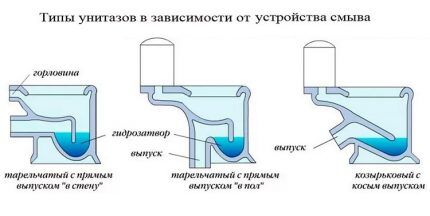
The angle of inclination of the oblique release varies from 30 to 75 degrees. You can always choose a model that best suits the existing sewer system. If the outlet of the plumbing fixture and the outlet to the sewer do not match, use corrugation for toilet, the specifics of which are outlined in the article we recommend.
If the pipelines in the toilet have not yet been laid, then the toilet needs to be selected according to the planned wiring so that it can be connected to the pipes later without problems.
Methods for fixing toilets on the floor and walls
When choosing a toilet, you have to think not only about its technical parameters, but also about the design of the model. Depending on the method of fastening and installation location, all plumbing fixtures under consideration are either wall-mounted or floor-mounted. The appearance of the plumbing greatly depends on the type of installation.
Looks more aesthetically pleasing wall hung toilet. It is raised above the floor, making it easier to clean underneath and in the toilet in general. True, to install it you need installation - a support frame fixed to the toilet wall or floor.
Floor-standing toilets are a classic for domestic homes. They are cheaper and easier to install. They do not require installation on the wall. Fastening is done directly to the floor using self-tapping dowels.
In both types of structures, the tank can be located behind a false wall in the installation. This option looks better, but makes repairs much more difficult. Moreover, even for banal adjustment of the fittings, you will have to disassemble the masking structure, so for its maintenance it is better to build plumbing hatch.
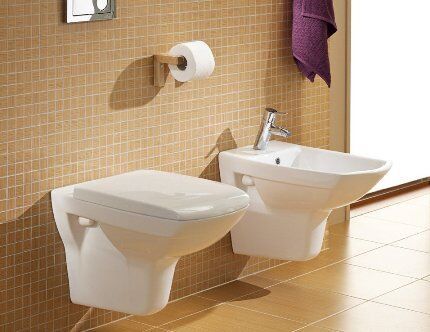
Additional functionality of plumbing fixtures
Technologies are developing by leaps and bounds, innovations have reached such an ordinary plumbing fixture as a toilet. You can find it on sale intelligent models with contactless water start, as well as illuminated and heated toilet seat. How much such innovations are needed is up to the owner of the home to decide.
One of the most popular additions to the toilet, allowing you to avoid buying an expensive electronic device, is a lining or bidet lid in the form of a structurally modified lid or nozzle with nozzles. It is installed on a regular toilet as an accompanying device.
Such bidets allow for hygienic washing and eliminate the use of toilet paper. They are easy to install and easy to operate.
After pressing the button, a spout with nozzles extends into the bowl and begins to spray jets. And after the procedures are completed, this tip is removed back, having previously been cleaned of dirt automatically.
In addition to the above additional accessories, the toilet can also be equipped with:
- a hygienic shower in the form of a watering can on a hose;
- self-cleaning system;
- block for smooth lowering of the lid;
- supplying detergents and fragrances to the bowl;
- air drying;
- musical equipment;
- air fresheners and aerators.
All these additions increase the price of the toilet, but make visiting the toilet more comfortable.
Conclusions and useful video on the topic
The videos offered for viewing will make it easier for you to study the existing model range of toilets in order to understand exactly how one type differs from another.
Video #1. A visual demonstration of the varieties of important plumbing fixtures:
Video #2. All about the flushing system in the toilet bowl:
Video #3. Recommendations from a professional plumber on choosing a toilet:
When choosing a toilet, you have to take into account the dimensions of the bathroom. By definition, installing a large bowl in a small toilet will not work; convenience should not be forgotten. A circular drainage system is more practical, but you can purchase a model with it only if the water in the pipes is soft and without salts - otherwise the holes in the gutter will quickly become clogged.
The visor bowl eliminates the formation of splashes, but forces you to use a brush more often. The plate version is the most losing. However, much of this choice depends on the purely personal preferences of the owner of the toilet.
Please write comments in the block below. Tell us which toilet option you preferred and why. Ask questions, share information that may be useful to site visitors, post photos related to the topic of the article.




We installed a wall-hung toilet in our apartment and are very pleased! It looks more compact, but at the same time it is rather large and quite comfortable. So far, not a single negative has been noticed about it. And this option makes cleaning the bathroom much easier. And, of course, I highly recommend not skimping on a bidet; now I can’t imagine life without it, but before I doubted its necessity.
The description does not include one of the main parameters of the toilet - the height of the water seal. The only way to combat the problem of water seal failure is to ensure its height is at least 65-70 mm. European toilets cannot provide a satisfactory flush quality. Therefore, in order to “fit in” the toilet to the consumer, manufacturers reduce the height of the water seal. Sometimes up to 30 mm.
Unhappy buyers who install such toilets in multi-storey buildings serviced by housing and communal services (they themselves understand what kind of service), especially in old houses, then suffer due to the failure of the water seal, suffer from the stench, etc. and so on. Stop selling “pig in a poke”! 🙁 GIVE INFORMATION ABOUT THE HEIGHT OF THE WATER SEAL!
A toilet seal failure is a very rare occurrence.And if the vent riser is in order - not clogged, not deformed, not structurally changed, then despite the height of the water seal of your toilet there will be no breakdowns.
The height of the water seal affects its “breakdown” to a much lesser extent than the absence or blockage of the drain pipe, which prevents the formation of a vacuum in the sewer pipes leading from the toilet (as well as other plumbing devices). When a large volume of wastewater moves, a kind of “water piston” is formed, which covers the entire cross-section of the pipeline and in the final phase, as it moves away from the plumbing fixture, simply “sucks” the water from the water seal.
But if you are away for a long time (or use the device very rarely), then the water from the water seal can simply evaporate and you are guaranteed a strong “aroma”. In this case, an oil film on the surface of the water can significantly help. In any case, the choice is yours and Google will help you!)
Until now I had a Soviet toilet. And the devil pulled me to install a new one. I gave the locksmith 7,000 rubles. for the toilet and the work, and shortly before that I changed the tank and also paid 3,000 rubles. Yesterday, an Uzbek plumber installed a new toilet for me, and I realized that I would not be able to use it. In the Soviet one the seat was wider, in this one it was narrower.
Inside the toilet, the surface was flat and, excuse me, it was clear how much had come out of me (I need to know this), a stream of water flushed everything away instantly. The new toilet does not have a flat surface, but a sloping one, and everything rolls down into the water like a sled down a hill. The water does not wash away at once, as it did in the old one. Here the water mixes with... and gurgles like soup in a pan.
Water does not wash away even toilet paper as thin as chiffon.I use 10 times more water compared to the old toilet. But even after the fifth try, the piece of paper dangles on top.
How can I find one like the one I had? Do they make these? Where do I put this now? 10 thousand down the drain. If you know whether there are Soviet-style toilets now, please let me know. What is it called? Can you tell me where I can buy one?
Hello. It's not a matter of Soviet-modern. The fact is that your store seems to have a small selection. You are interested in a toilet with a so-called “shelf”; commercially it is called “anti-splash”. And since we are being so frank, I will note that the shelf was not intended for counting... hmm... feces. It is designed to reduce the amount of splashes when flushing, and also to prevent falling... hmm... feces from splashing.
By the way, you can choose an anti-splash toilet on the Internet that is right for you. The width of the shelf and its angle of inclination may vary. However, like the seat. Choose a suitable model without leaving your home and ask the plumbing store to bring you one to order. Or go to a large store and there will be a larger selection of toilets. The main thing is to describe to the seller what exactly you need. Pay attention to: the angle of the shelf, its width, the width of the seat rim, the diameter of the seat, the capacity of the tank and the type of flush. Write down all these parameters and take them to the store.
I repeat - the shelf is called the anti-splash function! 🙂 Good luck!
I wrote so much in the box above and it turned out to be in the wrong place. I would buy a toilet with the hole moved forward and without a rim. This is the best option in my opinion. Walking with a brush after the procedure is not at all difficult.Instead of feeling splashes of fecal matter and bacteria every time.